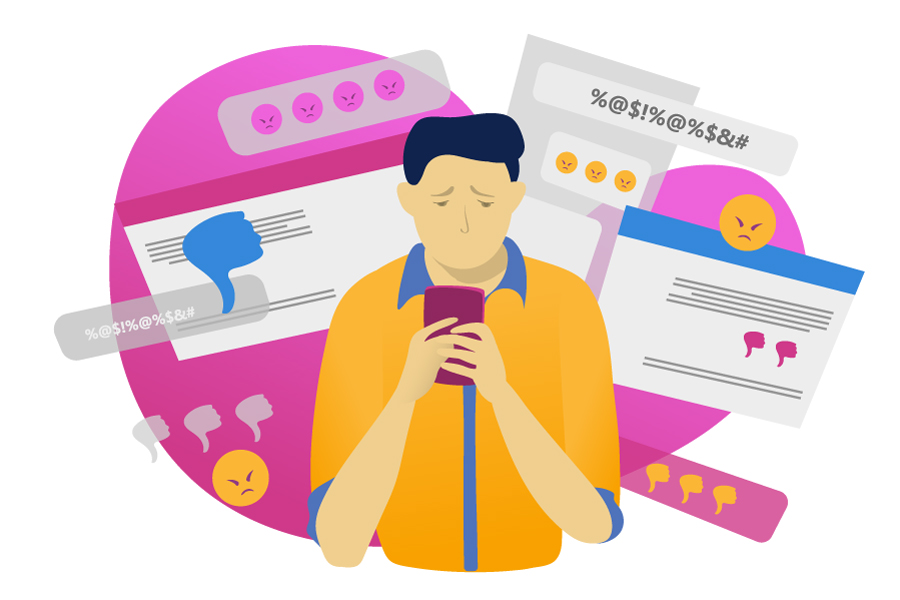In the past, bullies had limited access to your time and emotional energy. Harassment was confined to school halls, the street, or the office, and home was a safe haven for many. Today, a type of bullying exists that isn’t as obvious as being excluded from a lunch table or being criticized in the hallways. With the advent of technology and the Internet came the rise of cyberbullying.
The Difference Between Cyberbullying and Traditional Bullying
Like in-person or “traditional” bullying, cyberbullying happens intentionally and often repeatedly. But unlike traditional bullying, cyberbullies have access to millions of people across the Internet. Cyberbullying is harassment that occurs online or through digital devices and involves sharing or sending content intended to hurt, threaten, or humiliate someone. With a few clicks, a cyberbully can inflict damage through a torrent of toxic texts and scalding status updates, sharing pictures and information designed to harm.
How the Internet Changed Bullying
Social media, forums, and online games are bullies’ new schoolyards, and harassment can occur 24/7 because face-to-face contact isn’t required. Because cyberbullying occurs online, it often occurs anonymously. Anonymity can embolden bullies because they are less likely to be caught, and they often cross the line further than if the harassment occurred face-to-face.
Because they can’t see your reaction, they will go further to belittle, ridicule, and insult.
The widespread use of the Internet can amplify toxic behavior because harassment isn’t usually a closed interaction. With ease, a cyberbully can share humiliating content online to an audience of hundreds or thousands. Emails or texts can be forwarded, Snapchats can be screenshot and shared, and hurtful posts can be visible to potentially thousands, multiplying
the embarrassment because it is so far-reaching. Worse, an audience can participate in the hurt by commenting and sharing the content.
Cyberbullying is Increasing
Cyberbullying continues to increase because anyone can become or contribute to cyberbullying. You don’t need to have social status or physical advantage. All you need is access to the Internet. With a few clicks, you have the power to exclude, humiliate, shun others, and you can go from bullying victim to perpetrator in a moment.
With so much of our time spent in digital spaces, there are more opportunities to be cyberbullied. Between 2007 and 2019,
the prevalence of online bullying doubled, and nearly one-third of teenagers suffered from it at some point. The same devices
that connect us during social distancing or separation can spread toxicity in our lives. And with more and more of us spending time online- we spend 20% more time on social media than in pre-pandemic times- we are more likely to fall victim to cyberbullying. As of January 2020, 44% of internet users in the US said they had experienced online harassment. The social networks most fraught with bullying/harassment are YouTube, followed by Snapchat, Tik Tok, and Facebook. The most prevalent harassment was offensive name-calling, contributing to 37% of instances.
The Impact of Cyberbullying
The constant fear of when, where, and how a cyberbully will strike can plague victims, leading to anger, anxiety, depression, feelings of helplessness, low self-esteem, and even suicidal thoughts. Just because cyberbullying happens behind a screen doesn’t make the impact less damaging, and the distress experienced online has a real-world impact. What happens online doesn’t stay online, and victims carry shame and fear in their lives.
Victims of cyberbullying have an increased risk of developing mental health problems like depression, low self-esteem, anxiety, or PTSD. In a study, two-thirds of bullied adolescents said it negatively impacted how they feel about themselves, and 13% said it affected their physical health. Some of the effects of cyberbullying are stronger than traditional bullying because the victim often can’t escape the abusive situation. The Internet and digital spaces have many different avenues of access, from social media to texting to online forums, and cyberbullies aren’t limited by physical location.
Signs of Online Bullying
Victims of cyberbullying often stay silent because of shame and embarrassment. Knowing what to watch for can help you identify when someone is being cyberbullied. Signs include:
- Increased feelings of depression, anxiety, and mood swings
- Changes in sleep patterns or appetite changes
- Suicidal thoughts or ideation
- Becoming sad, angry, or distressed during or after being online.
- Appear anxious when viewing a text, email, or social media post.
- Low self-esteem or self-worth
- Withdrawing from friends or activities they used to enjoy
- Spending more time alone
- Poor academic or work performance
- Problems in relationships with family and friends
- Self-harming behaviors
- Starting or increasing substance use
- Increased anger, irritability, or outbursts
How to Respond to Cyberbullying
If you or someone you know is being cyber-bullied, it’s important to recognize that this is not your fault. Don’t blame yourself or beat yourself up – the bully is the one who made the conscious choice to spread toxicity and negativity. No one, including you, deserve to be treated this way. Your feelings are valid, and there is no shame in being who you are.
Curb the Hurt
Don’t amplify the hurt by rereading messages or replaying scenarios. Instead, focus on the positives in
your life.
Refrain from Engaging
Don’t respond to the cyberbully’s attacks, regardless of how hurtful or untrue. Provoking a reaction
from you is the cyberbully’s goal, and engaging only provides more fuel to the fire.
Revenge Isn’t the Answer
Don’t seek revenge by contributing to bullying online. It will only make the problem worse and can
result in serious legal consequences. If you wouldn’t say it in person, don’t say it online.
Keep the Evidence
Screenshot or otherwise save harassing texts or posts. You may want to record the incidents if you need to file a report or prove what happened.
File a Report
Report the incident to the website or social media site it happened on. They have policies against abuse, and whoever violates those policies will likely get notified and prevented from using that site. If you don’t report incidents, the cyberbully may become more aggressive. Report threats of harm and inappropriate sexual messages to the police. In many cases, the cyberbully’s actions can be prosecuted by law.
Block the Bully
Prevent communication from the cyberbully, by blocking their email address, cell phone number, and deleting
them from social media contacts. Report their activities to their Internet service provider (ISP) or to any social media or other websites they use to target you. The cyberbully’s actions may constitute a violation of the website’s terms of service or, depending on the laws in your area, may even warrant criminal charges.
Seek Support
If you’re being bullied online, seek support from a friend, family member, counselor, or someone you can trust. You have the right to be safe, and having someone to listen and support you through the process can make a big difference.
When you’re coping with difficult situations in your life, like bullying, talking with a counselor who can offer support and guidance is one of the best things you can do. Employee & Family Resources offers compassionate, affordable counseling to support you. Learn about EFR counseling services or meet our dedicated counselors today!
For more information and resources about cyberbullying, visit https://www.stompoutbullying.org/about-bullying-and-cyberbullying





